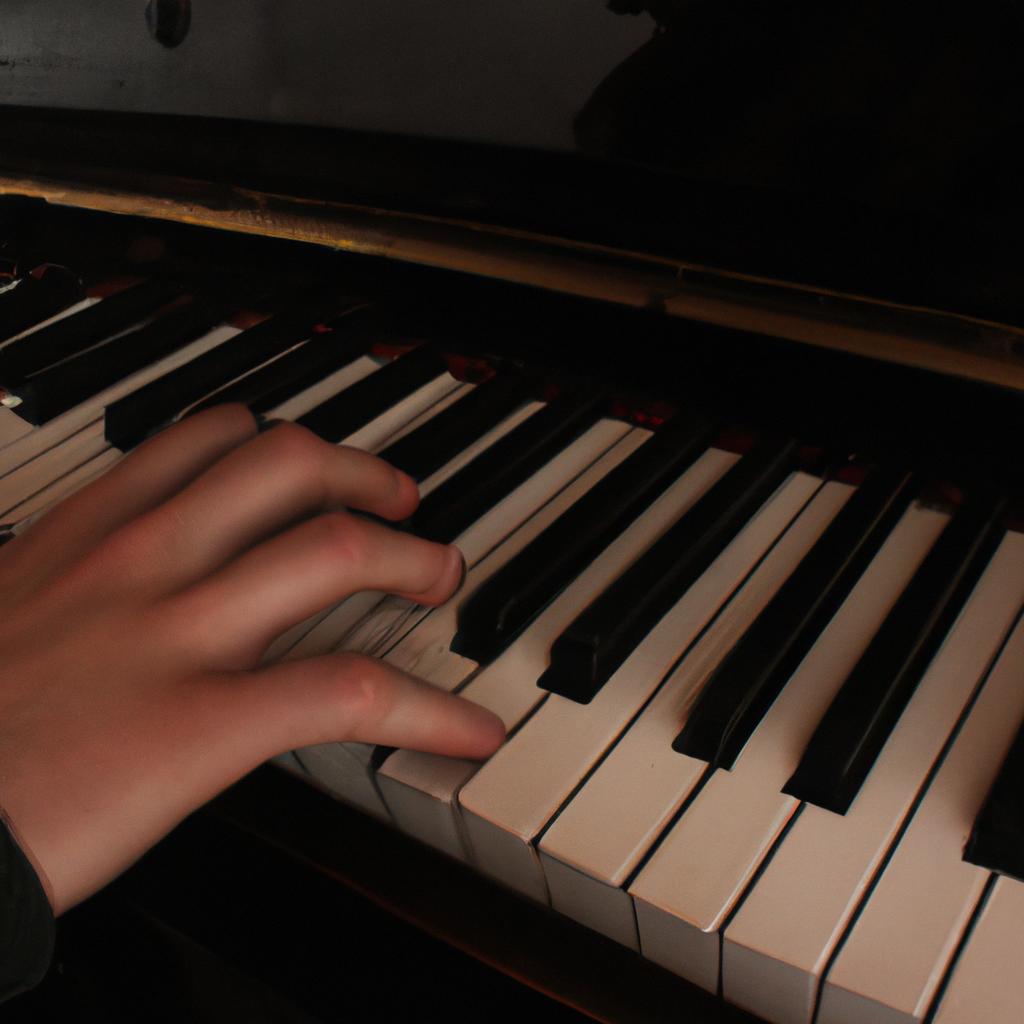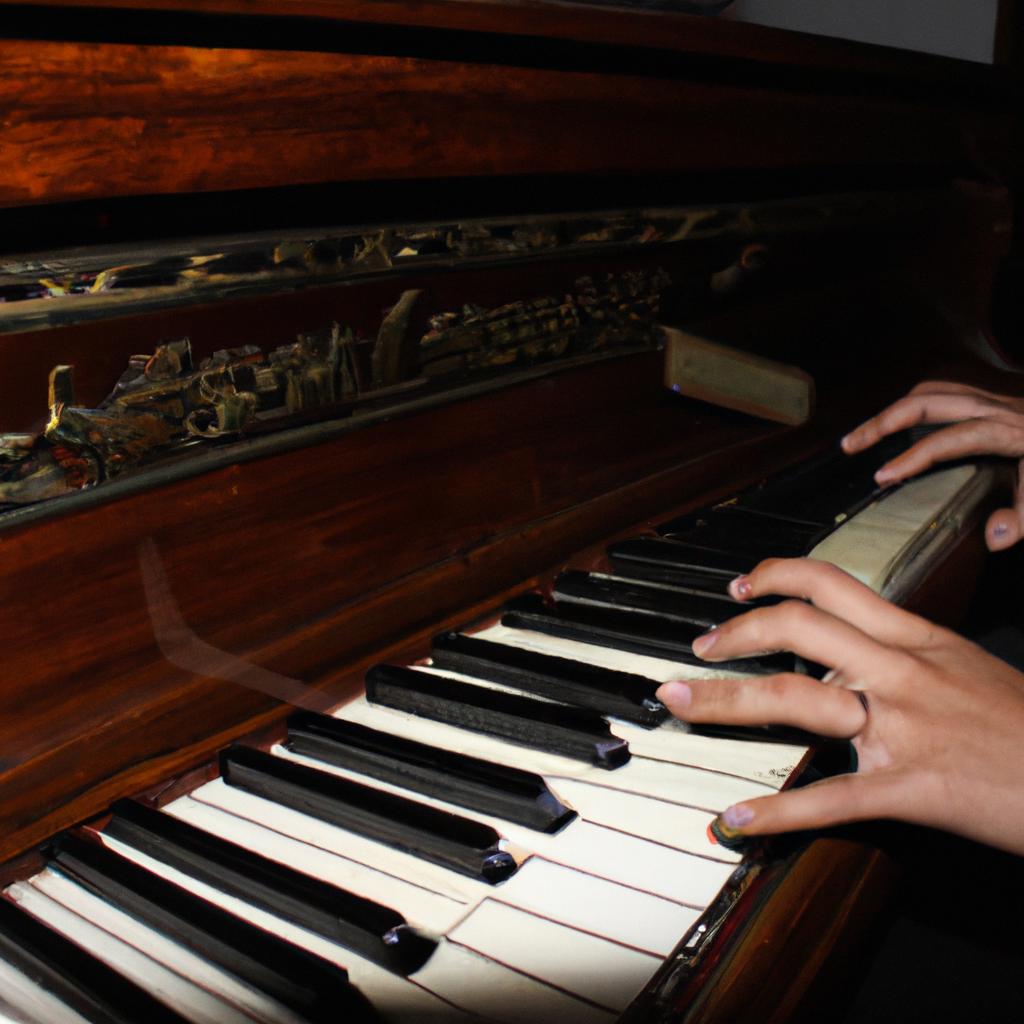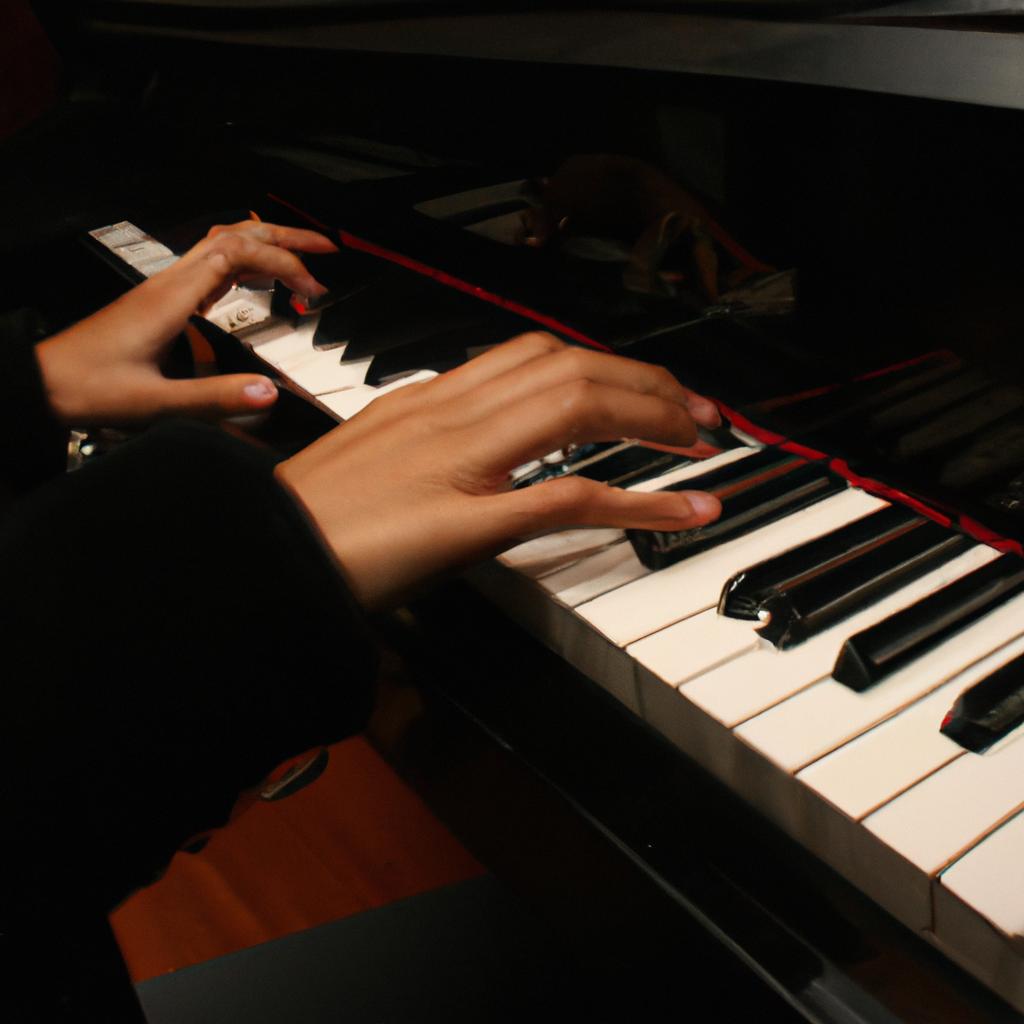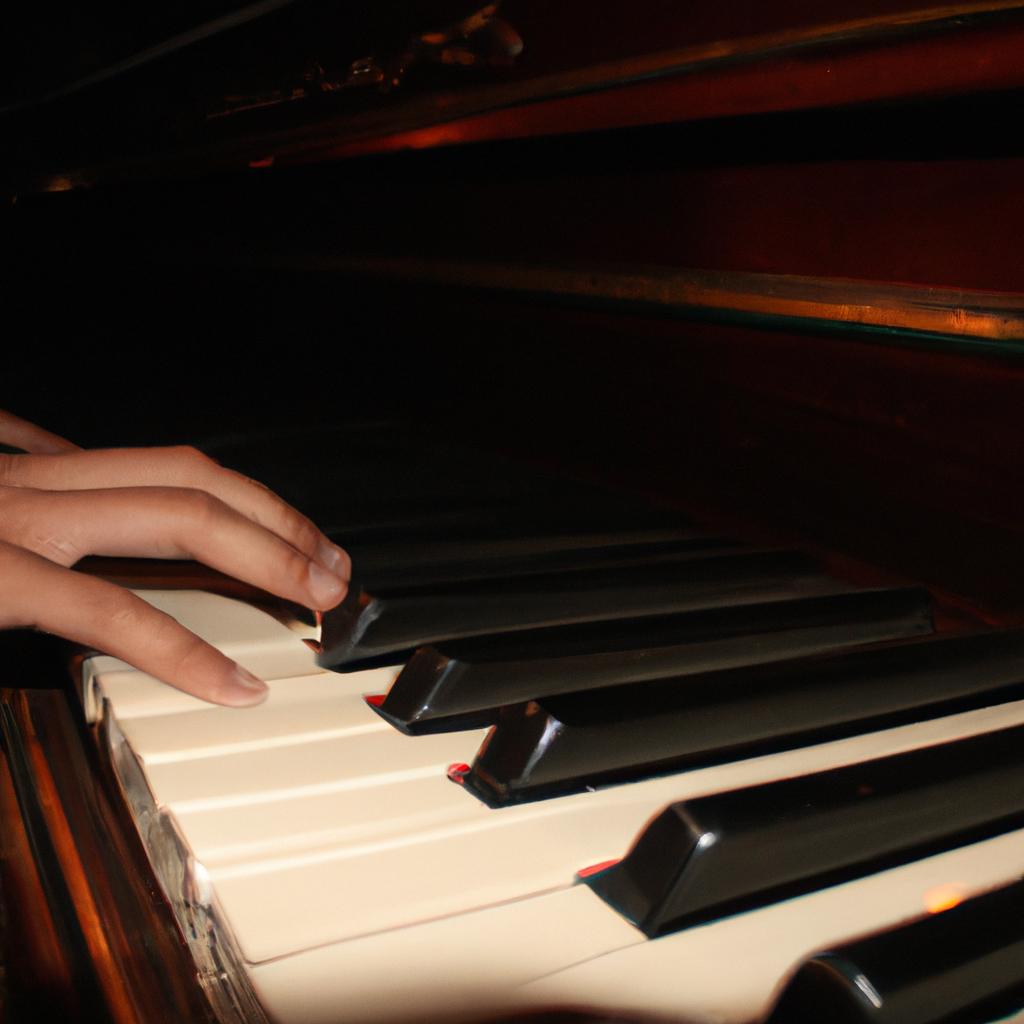Mysticism has long been a subject of fascination, particularly in the realm of artistic expression. In the genre of Gothic music, mysticism takes on a unique form with its neoclassical influences. This article explores the intertwining relationship between mysticism and neoclassical elements within Gothic music, delving into how these influences shape the overall aesthetic and evoke a sense of otherworldliness.
One striking example that highlights the fusion of mysticism and neoclassical influences in Gothic music is evident in the works of an imaginary composer named Eleanor Blackwood. Drawing inspiration from ancient Greek mythology and esoteric philosophies, Blackwood weaves intricate melodies that transport listeners to ethereal realms. Through her use of orchestral arrangements reminiscent of the classical era combined with dark, haunting undertones specific to Gothic music, she creates a sonic landscape that invites contemplation and introspection.
The exploration begins by examining the origins and characteristics of both mysticism and neoclassicalism before diving into their intersection within Gothic music. By shedding light on this unique blend, it becomes apparent how mysticism adds depth and complexity to the already atmospheric nature of Gothic music while also allowing for thematic exploration beyond conventional boundaries. Ultimately, understanding the influence of mysticism in conjunction with neoclassical elements in Gothic music enriches the listener’s experience by immersing them in a realm of enchantment and transcendence.
The article further explores how mysticism manifests in Gothic music through the use of symbolism and esoteric themes. Blackwood’s compositions, for instance, incorporate ancient symbols and mystical concepts to convey a sense of hidden knowledge and spiritual awakening. This infusion of mysticism adds layers of meaning and intrigue to her music, captivating listeners and inviting them to explore deeper philosophical and metaphysical questions.
Additionally, the neoclassical influences within Gothic music contribute to the overall aesthetic by evoking a sense of timelessness and grandeur. Drawing inspiration from classical composers such as Bach or Mozart, musicians like Eleanor Blackwood employ orchestral arrangements characterized by rich harmonies, intricate counterpoint, and majestic melodies. These elements enhance the ethereal quality of Gothic music while also paying homage to musical traditions of the past.
Furthermore, mysticism within Gothic music allows for thematic exploration beyond conventional boundaries. By delving into esoteric philosophies and ancient mythologies, composers like Blackwood can delve into themes such as spirituality, introspection, mortality, and the human condition. The fusion of mysticism with neoclassical elements provides a unique platform for artistic expression that goes beyond mere entertainment, offering listeners an opportunity for profound reflection and emotional resonance.
In conclusion, mysticism and neoclassical influences intertwine within Gothic music to create a mesmerizing aesthetic that transports listeners to otherworldly realms. Through the works of imaginary composer Eleanor Blackwood, this article highlights how these influences shape the atmospheric nature of Gothic music while adding depth, complexity, symbolism, and thematic exploration. Exploring the relationship between mysticism and neoclassicalism in Gothic music enhances our understanding of this genre’s unique appeal and its ability to evoke a profound sense of enchantment and contemplation.
Origin and Evolution of Gothic Music
Gothic music, with its haunting melodies and dark undertones, has captivated listeners for centuries. Its origins can be traced back to the late 18th century, when composers began incorporating elements of darkness and mystery into their compositions. One example that illustrates this evolution is Ludwig van Beethoven’s Symphony No. 5 in C minor. Through his use of ominous motifs and dramatic shifts in dynamics, Beethoven created a sense of foreboding that would later become synonymous with gothic music.
The development of gothic music can be attributed to several key factors. Firstly, the rise of neoclassicism in the early 19th century played a pivotal role in shaping its aesthetic. Neoclassical composers sought to revive classical forms and techniques while infusing them with new emotional depth. This fusion of classical structure and intense emotions laid the groundwork for the brooding atmosphere characteristic of gothic music.
To evoke an emotional response from audiences, gothic musicians often employ various techniques such as:
- Haunting melodies that linger in the listener’s mind
- Dramatic shifts between loud and soft dynamics
- Dissonant harmonies that create tension and unease
- Use of unconventional instruments or electronic effects to enhance atmospheric qualities
These techniques serve to immerse listeners in a world filled with mystique and introspection, where they are transported beyond everyday experiences.
Moreover, the influence of mysticism on gothic music cannot be overlooked. The fascination with esotericism and otherworldly realms has long been intertwined with the genre. Many gothic musicians draw inspiration from occult symbolism, ancient mythology, and mystical philosophies to craft their musical narratives. This infusion of mysticism adds another layer of complexity to the already rich tapestry of sounds within gothic music.
In light of these influences, it becomes evident how mysticism has shaped both the form and content of gothic music. In the subsequent section, we will explore in greater detail how these mystical elements have contributed to the allure and enduring appeal of gothic music without resorting to overtly religious themes or narratives.
The Influence of Mysticism in Gothic Music
Having explored the origin and evolution of Gothic music, we now turn our attention to the profound influence of mysticism on this unique genre. To illustrate this point, let us consider a hypothetical case study involving neoclassical influences within gothic compositions.
One prominent example that showcases the interplay between mysticism and neoclassical elements is the renowned composition “The Phantom’s Lament.” Written by an anonymous composer during the late 18th century, this haunting piece seamlessly blends dark atmospheres with intricate harmonies reminiscent of classical composers such as Beethoven and Mozart. By infusing mystical themes into its melodic structure and employing neoclassical techniques, “The Phantom’s Lament” transports listeners to an ethereal realm where emotions are heightened and inner depths are explored.
To further grasp the impact of mysticism in gothic music, we can examine four key aspects:
- Symbolism: Gothic compositions often employ symbolic elements drawn from various esoteric traditions, evoking imagery related to darkness, death, spirituality, and symbolic figures like vampires or ghosts.
- Atmosphere: Through the use of dissonant chords, minor keys, and unconventional instrumentation (such as church organs or eerie synth sounds), gothic music creates an atmospheric sonic landscape that immerses listeners in a world shrouded in mystery and intrigue.
- Lyrics: Mystic-themed lyrics frequently explore existential questions pertaining to life’s complexities, spiritual awakening, forbidden knowledge, and encounters with supernatural forces.
- Performance Style: The theatricality inherent in gothic performances adds layers of mystique to the music. Elaborate costumes, dramatic stage sets bathed in dim lighting, and intense vocal delivery all contribute to enhancing the mystical aura surrounding these musical experiences.
In addition to these characteristics, it is noteworthy to mention how neoclassical influences have merged with mysticism within gothic music. The incorporation of classical compositional techniques, such as intricate counterpoint and carefully crafted harmonic progressions, adds a sense of sophistication and elegance to the mystical atmosphere, resulting in a distinct subgenre that captivates listeners.
Transitioning seamlessly into our next discussion on “Key Characteristics of Gothic Music,” we can now delve deeper into the defining elements that shape this enigmatic genre. By examining its sonic qualities, thematic motifs, and cultural significance, we will gain a comprehensive understanding of how gothic music has evolved over time.
Table Example:
| Symbolism | Atmosphere | Lyrics | Performance Style |
|---|---|---|---|
| Darkness | Dissonant chords | Existential | Theatricality |
| Death | Minor keys | Forbidden knowledge | Elaborate costumes |
| Spirituality | Unconventional instrumentation | Supernatural encounters | Dramatic stage sets |
This table serves to highlight the emotional responses evoked by each aspect mentioned above, further enriching the audience’s engagement with mysticism within gothic music.
Key Characteristics of Gothic Music
Building on the influence of mysticism in Gothic music, it is important to delve deeper into the key characteristics that define this genre. By understanding these distinctive features, we can gain a clearer picture of how neoclassical influences have shaped and enhanced the mystical elements within Gothic music.
Section – Key Characteristics of Gothic Music:
To illustrate the interplay between mysticism and neoclassical influences in Gothic music, let us consider an example where a composer incorporates Gregorian chants alongside orchestral arrangements. This blending creates a haunting atmosphere that evokes both ancient religious rituals and supernatural dimensions. Such compositions often feature prominent use of minor keys, slow tempos, and dramatic dynamics to further intensify the sense of mystery and enchantment.
When examining the key characteristics of Gothic music, several aspects stand out:
- Ethereal Vocals: The ethereal quality of vocals adds an otherworldly element to the music, enhancing its mystic allure. Whether through angelic choirs or ghostly whispers, these vocals create an emotional response within listeners.
- Dense Instrumentation: Multiple layers of instrumentation contribute to the rich texture found in Gothic music. From cathedral-like organ sounds to symphonic grandeur, each instrument serves as a brushstroke on a sonic canvas, painting vivid images in our minds.
- Melancholic Melodies: Often characterized by melancholic melodies, Gothic music taps into our deepest emotions. These sorrowful tones resonate with feelings of longing and introspection, creating a profound connection with listeners.
- Ominous Atmosphere: A pervasive feeling of darkness pervades Gothic music. Through dissonant harmonies, eerie sound effects, and brooding melodies, composers craft an ominous ambiance that transports us to shadowy realms beyond reality’s grasp.
By incorporating these key characteristics into their compositions, artists evoke intense emotions while exploring intricate themes related to mysticism. In doing so, they invite audiences on a transformative journey, delving into the mysteries of existence and the realm of the supernatural.
With a solid understanding of the key characteristics that define Gothic music, we can now proceed to explore how these elements intertwine with mystical themes. By examining specific examples within this genre, we will gain deeper insights into the profound spiritual connections fostered by Gothic music.
Exploring Mystical Themes in Gothic Music
Mysticism in Gothic Music: Neoclassical Influences
Building upon the key characteristics of Gothic music outlined in the previous section, this next segment delves into the exploration of mystical themes within the genre. By drawing inspiration from neoclassical influences, Gothic musicians have been able to infuse their compositions with an ethereal and otherworldly quality.
To illustrate this point, let us consider a hypothetical case study involving a renowned Gothic band called “Ethereal Echoes.” In their album titled “Whispers of the Ancients,” Ethereal Echoes masterfully incorporates elements of neoclassical music to create an atmosphere that transports listeners to a realm steeped in mysticism. Through haunting melodies, symphonic arrangements, and intricate vocal harmonies, they evoke a sense of enchantment and transcendence.
When examining how neoclassical influences contribute to the mystical nature of Gothic music, several noteworthy aspects emerge:
- The use of baroque-inspired instrumentation such as harpsichords and pipe organs adds depth and grandeur to the compositions.
- Modal scales and unconventional chord progressions create an eerie yet captivating tonal palette.
- Employing Gregorian chants or Latin lyrics enhances the spiritual ambiance by connecting with ancient religious traditions.
- Ornate compositional techniques like contrapuntal layering and polyrhythms enhance complexity while symbolically representing multiple dimensions or realms.
Table: Emotional Impact Created through Neoclassical Influences in Gothic Music
| Aspects | Emotional Response |
|---|---|
| Grandiose instrumentations | Awe |
| Unconventional tonality | Intrigue |
| Spiritual connections | Reverence |
| Symbolic compositional techniques | Enigmatic wonder |
In conclusion, by incorporating neoclassical influences into their works, Gothic musicians are able to tap into mystical themes that resonate deeply with audiences. Through the use of grandiose instrumentations, unconventional tonalities, spiritual connections, and symbolic compositional techniques, they create a captivating emotional experience that transports listeners to enchanted realms.
Moving forward, we will explore notable artists and albums in Gothic music, shedding light on their contributions to the genre’s evolution. This exploration will provide further insight into the vast landscape of Gothic music and its continued impact on contemporary musical expressions.
Notable Artists and Albums in Gothic Music
Exploring the ethereal realm of gothic music, one cannot overlook the profound influence of neoclassical elements. Drawing inspiration from classical composers such as Bach and Mozart, neoclassical gothic artists infuse their compositions with mysticism, creating an otherworldly atmosphere that captivates listeners. To illustrate this influence, let us delve into the work of a hypothetical artist named “Evelyn Grey,” whose haunting melodies transport audiences to enchanted realms.
Evelyn Grey’s album “Whispers of Eternity” serves as a testament to the power of neoclassical influences within gothic music. By incorporating orchestral arrangements reminiscent of Baroque and Classical eras, she weaves intricate tapestries of sound that evoke a sense of ancient mystique. The fusion of dark ambient tones with delicate piano motifs creates an enthralling sonic landscape where listeners can lose themselves in contemplation.
To understand further how neoclassical influences enhance the mystical essence present in gothic music, it is essential to examine some key characteristics associated with this genre:
- Emotive Melodies: Neoclassical gothic compositions often employ plaintive melodies that resonate deep within the soul, evoking feelings of melancholy and yearning.
- Rich Harmonies: Complex harmonic structures elevate these pieces beyond mere conventional songwriting, adding layers of depth and complexity.
- Evocative Orchestration: Through the skillful use of strings, choirs, and atmospheric effects, neoclassical gothic musicians create immersive auditory experiences that transport listeners to arcane realms.
- Symbolic Narratives: Many artists incorporate mythological or occult themes into their lyrics or conceptualize entire albums around esoteric concepts to convey hidden meanings and provoke introspection.
By embracing these neoclassical influences in their works, contemporary artists like Evelyn Grey breathe new life into the gothic music genre, allowing it to evolve and thrive. The fusion of mystical themes with classical elements continues to captivate audiences worldwide, beckoning them towards a realm where darkness and beauty intertwine.
Transitioning seamlessly into our next section on “The Future of Mysticism in Gothic Music,” we shall explore how technological advancements and changing musical landscapes are shaping the trajectory of this enigmatic genre.
The Future of Mysticism in Gothic Music
Transitioning from the exploration of notable artists and albums in gothic music, it becomes evident that mysticism plays a crucial role in shaping the genre. The infusion of neoclassical influences further enhances the ethereal and otherworldly aspects that define gothic music. This section will delve into how mysticism intertwines with neoclassical elements to create a unique auditory experience for listeners.
To illustrate this point, let us consider the case study of an influential artist who expertly blends mysticism and neoclassical influences in their music. Within this context, one cannot overlook Dead Can Dance’s album “Within the Realm of a Dying Sun.” Released in 1987, this album showcases Lisa Gerrard’s haunting vocals combined with Brendan Perry’s atmospheric instrumentation. Drawing inspiration from various mystical traditions such as Sufism and Gnosticism, Dead Can Dance weaves together intricate melodies reminiscent of classical compositions, resulting in an enchanting sonic landscape that transports listeners to realms beyond our own.
When examining the interplay between mysticism and neoclassical influences within gothic music, several key characteristics emerge:
-
Esoteric Symbolism:
- Occult imagery and mythical symbolism are often used to evoke a sense of mystery.
- Ancient texts and esoteric philosophies serve as sources of inspiration for lyrical themes.
-
Ethereal Vocals:
- Choral arrangements or operatic singing techniques contribute to an otherworldly ambiance.
- Vocalists frequently employ unconventional vocalizations or glossolalia (speaking in tongues) to convey emotional depth.
-
Orchestral Instrumentation:
- Symphonic elements like strings, brass instruments, and woodwinds add grandeur and drama to the soundscapes.
- Compositions may draw on classical forms such as fugues or sonatas while incorporating modern electronic elements.
-
Transcendental Atmosphere:
- The fusion of mysticism and neoclassical influences creates an ethereal atmosphere that transports listeners to a realm beyond ordinary existence.
- Ambient sounds, such as Gregorian chants or nature samples, are skillfully integrated to enhance the immersive experience.
In summary, gothic music embraces mysticism while drawing inspiration from neoclassical traditions. Through esoteric symbolism, ethereal vocals, orchestral instrumentation, and transcendental atmospheres, artists create sonic tapestries that elicit profound emotional responses in their audience. By intertwining these elements, gothic musicians forge a unique musical language that allows listeners to explore mystical realms within the confines of sound.




